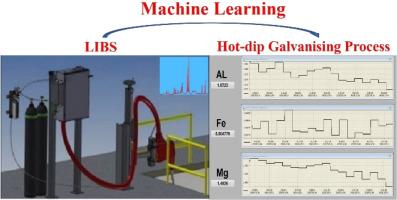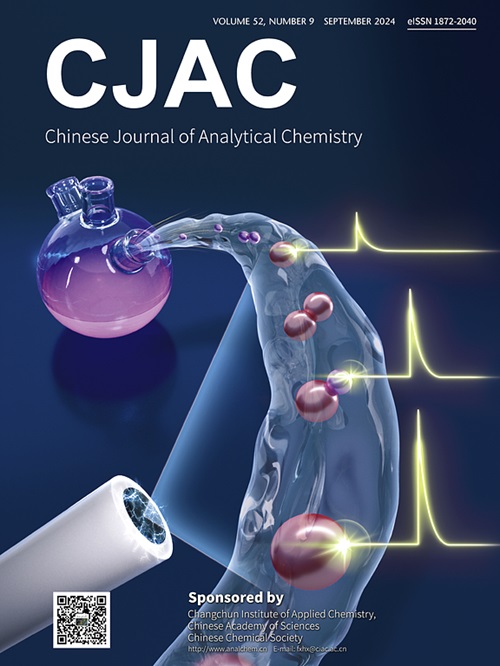基于激光诱导击穿光谱与机器学习算法的熔融锌中三种元素(铝、镁和铁)的快速定量分析
IF 1.3
4区 化学
Q4 CHEMISTRY, ANALYTICAL
引用次数: 0
摘要
热镀锌是防止金属腐蚀最经济有效的方法之一,因此被广泛应用于各个领域。开展热镀锌过程中化学元素定量分析技术和装置的研究与开发,可为提高热镀锌过程的效率和降低能耗提供理论依据和技术支持。本研究开发了一种机器学习辅助 LIBS,结合可编程逻辑控制器(PLC),用于同时在线/现场监测热镀锌溶液(锌液)中的多种元素。在优化的实验条件下采集了现场热镀锌溶液的 LIBS 光谱数据。为了进一步降低实验噪声对分析性能的影响,对现场 LIBS 光谱数据进行了预处理,并根据归一化和主成分分析-马哈罗诺比距离(PCA-MD)筛选出异常光谱数据。在优化数据的基础上,构建了现场热镀锌溶液三个关键要素的成分预测模型。基于 Python 和 LabVIEW 实现了模型的存储和重新调用,从而实现了对现场热镀锌溶液成分含量的实时预测。结果表明,随机森林模型的预测结果最好,其中 Al 的 R2 为 0.9978,RMSE 为 0.0013%;Mg 的 R2 为 0.9984,RMSE 为 0.0011%;Fe 的 R2 为 0.9932,RMSE 为 0.0001%。从所建模型的现场分析结果来看,其铝、镁和铁的 MRE 分别为 0.0098、0.0236 和 0.2102。综上所述,本研究构建的结合机器学习的热镀锌溶液现场/在线分析系统性能优异,可以满足热镀锌溶液生产现场的需要。本研究有望为冶金领域其他生产现场的质量控制和工艺优化提供理论依据和技术参考。本文章由计算机程序翻译,如有差异,请以英文原文为准。

Rapid quantitative analysis of three elements (Al, Mg and Fe) in molten zinc based on laser-induced breakdown spectroscopy combined with machine learning algorithm
Hot-dip galvanizing represents one of the most cost-effective methods for the prevention of metal corrosion, and is therefore employed extensively across a range of fields. Carrying out the research and development of technology and devices for quantitative analysis of chemical elements in hot-dip galvanising process can provide theoretical basis and technical support for the efficiency of hot-dip galvanising process and reduction of energy consumption. A machine learning-assisted LIBS combined with a programmable logic controller (PLC) for simultaneous on-line/in-site monitoring of multiple elements in hot-dip galvanising solution (molten zinc) was developed in the current study. The LIBS spectral data of the on-site hot-dip galvanising solution was collected under optimised experimental conditions. In order to further reduce the influence of experimental noise on the analysis performance, the on-site LIBS spectral data were preprocessed and anomalous spectral data were screened based on normalisation and principal component analysis-Mahalanobis distance (PCA-MD). On the basis of the optimised data, component prediction models for three key elements of on-site hot-dip galvanising solution were constructed. The storage and re-call of the model was achieved based on Python combined with LabVIEW, thus real-time prediction of the on-site component content of hot-dip galvanising solution was achieved. The results show that the random forest model presents the best prediction results, in which the R2 is 0.9978 and the RMSE is 0.0013% for Al, the R2 is 0.9984 and the RMSE is 0.0011% for Mg, and the R2 is 0.9932 and the RMSE is 0.0001% for Fe. From the on-site analysis results of the constructed model, its MRE of Al, Mg and Fe is 0.0098, 0.0236, and 0.2102, respectively. In summary, the in-situ/on-line analysis system of hot-dip galvanising solution combined with machine learning constructed in this study shows excellent performance, which can satisfy the needs of hot-dip galvanising solution production site. This study is expected to provide theoretical basis and technical reference for quality control and process optimisation in other production sites in the metallurgical field.
求助全文
通过发布文献求助,成功后即可免费获取论文全文。
去求助
来源期刊
CiteScore
3.60
自引率
25.00%
发文量
17223
审稿时长
35 days
期刊介绍:
Chinese Journal of Analytical Chemistry(CJAC) is an academic journal of analytical chemistry established in 1972 and sponsored by the Chinese Chemical Society and Changchun Institute of Applied Chemistry, Chinese Academy of Sciences. Its objectives are to report the original scientific research achievements and review the recent development of analytical chemistry in all areas. The journal sets up 5 columns including Research Papers, Research Notes, Experimental Technique and Instrument, Review and Progress and Summary Accounts. The journal published monthly in Chinese language. A detailed abstract, keywords and the titles of figures and tables are provided in English, except column of Summary Accounts. Prof. Wang Erkang, an outstanding analytical chemist, academician of Chinese Academy of Sciences & Third World Academy of Sciences, holds the post of the Editor-in-chief.

 求助内容:
求助内容: 应助结果提醒方式:
应助结果提醒方式:


